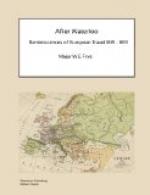precious stones of all kinds with which it abounds,
I was reminded of Aladdin and began to fancy myself
in the cavern of the Wonderful Lamp. This church
was built by Galeazzo Visconti, whose coffin is here,
and his statue also, in white marble. There are
several bas-reliefs of exquisite workmanship.
There are no fewer than seventeen altars here and
of the most beautiful structure you can conceive, being
inlaid in mosaic with jasper, onyx and lapis-lazuli.
Besides these precious marbles of every colour and
quantity under heaven, here are abundance of rubies,
emeralds, amethysts, aquamarines and topazes, incrusted
in the different chapels and altars. Here again
is a proof of the falsehood and injustice of the aspersions
cast on the French army, as being the plunderers of
churches; for if they were so, how comes it that the
Certosa the richest of all, was spared?
Mr Eustace[119] in his admiration of Church splendour,
should at least have given the French no small degree
of credit for their abstinence from so rich a prize.
A canal runs parallel to the road the whole way from
Milan to Pavia, where it joins the Tessino. The
banks of the Canal and each side of the road are lined
with poplars. Pavia is one of the most ancient
cities in Italy and has something very antique and
solemn in its appearance. It is quite Gothic and
was the capital city of the Lombard Kings. The
streets are broad and the
Piazza is large.
I could not find any traces of the ancient palace of
the Lombard Kings, which I should like much to have
done; for then I should have endeavoured to make out
the chamber into which Jocondo peeped and discovered
what cured him of his melancholy, and where the impatient
Queen received the petulant answer from her beloved
Nano, conveyed by one of her waiting maids who told
her:
E per non stare in perdita d’un
soldo,
A voi nega venire fl manigoldo.[120]
Nor, lest he lose a doit, his paltry stake,
Will that discourteous churl his game
forsake
—Trans. W.S. ROSE.
MILAN, 28th June.
I have been to the Scala theatre, to see the
Ballet of the Vestal, one of the most interesting
Ballets I ever beheld. Oh! what a mighty magician
is the ballet master Vigano, and as for the prima ballerina,
Pallerini, what praises can equal her merit? then,
the delightful soul soothing music, so harmonious,
so pathetic, and the decorations so truly tasteful
and classical! I can never forget the impression
this fascinating Ballet made on me. It is called
La Vestale. It opens with a view of the
Circus in ancient Rome, and various gymnastic exercises,
combats of gladiators, of athletes, and ends with
a chariot race with real horses. The Roman Consuls
are present in all their pomp, surrounded by Lictors
with axes and fasces. The Vestal virgins assist
at this spectacle, and from one of them the victor
in the games receives a garland, as the recompense




